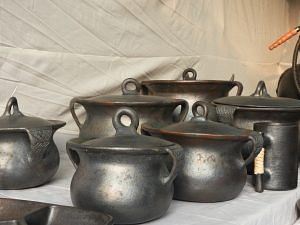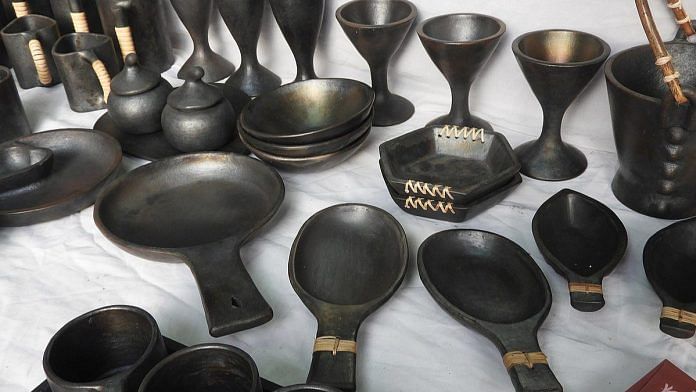Recognisable through its characteristic black colour and minimalist design, Longpi pottery is an indigenous craft practised in the district of Ukhrul, Manipur in Northeast India. Made without using the potter’s wheel, the craft is traditionally a domain of the men of the Tangkhul Naga community, although women are not prohibited from practising it. Locally called Longpi ham or hampai, it derives its name from the villages of Longpi Khullen and Longpi Kajui, which yield the material used in its making. Longpi pottery traditionally comprised cookware, but now also includes storage and serving vessels for food and beverages.
While the exact origins of the Longpi pottery tradition are unknown, local mythology links the craft with the goddess Panthoibi, an ancient Manipuri deity associated with handicraft. Historically, the Longpi region formed a meeting place for several villages, including those of neighbouring Nagaland, and the craftspeople traded the pottery in exchange for salt.
Longpi pottery is made using a mixture of two materials, leshong lung (black serpentine stone) and leshon or salla nali (weathered reddish-brown rock), which are found in abundance in the area. The two minerals, quarried from the local landscape using hand tools, are thoroughly dried for a few days before they are evenly powdered using shamkhur, a wooden mortar and suk, a pestle, mixed with water in a wooden trough, and kneaded to make a homogenous clay.

Also read: Abanindranath Tagore rejected European art. Promoted Hindu spirituality to convey ‘Indianness’
A portion of this is separated and rolled flat to make the base for the pot. The rest is rolled out to make the wall of the pot: it is flattened — initially using the hands, and then a cylindrical roller — to obtain a length with an even, predetermined thickness. This is cut to the required length and breadth using a bamboo-bladed knife before it is curved into a cylinder and placed vertically on the circumference of the base on a stand.
A moist paste of the same clay is used to seal the edges of the cylinder and join it to the base. Moving around the working block or using a rotatable stand, the potter then shapes the vessel, keeping one hand on the inside while continuously beating the clay from the outside using a wet hamkapi, a wooden or bamboo paddle with a cylindrical handle and flat head, while keeping the clay moist to keep it from cracking. The potter uses various sizes and shapes of paddles, and the flat heads may be wrapped with jute, cane or other materials, which help retain moisture and lend texture to the pot.
A bamboo scraper is used to even out the edges, remove excess clay or dirt, and sometimes to etch motifs or patterns onto the surface when the pot is semi-dry. The surface is smoothened and polished using a variety of implements such as brushes, stones and marbles. The pot is then air-dried for four to twelve days, usually over the hearth inside the house, before it is fired in an open furnace or a closed kiln to about 800º Celsius. Once cooled by wrapping in dry grass, it is polished by rubbing with the leaves of the local sahi tree (Lithocarpus dealbatus), which imbue it with its distinctive sheen. Cane or other decorative materials may later be added to the handles or other ancillary parts of the pot.
While appropriate pieces of bamboo have traditionally been used as rollers and moulds, some artisans currently use easily available materials like PVC pipes, and create base forms with plaster of Paris, over which the clay is first moulded.
At present, initiatives like Mathew Sasa Craft, started by Longpi craftsperson Mathew Sasa in Delhi in 2007, and USTTAD (Upgrading the Skills and Training in Traditional Arts/Crafts for Development) started by the Ministry of Minority Affairs in September 2015, are working to preserve the craft and support the craftsmen who are still engaged in it.
Sasa, who founded the former initiative to train artisans and popularise the craft, comes from a family of potters in Manipur; his father Machihan Sasa is recipient of the National Awards Certificate (1988) and the Shilp Awards by the Ministry of Textiles (2008) for his contributions towards advancing Longpi pottery. Mathew Sasa’s initiatives and participation in national and international fairs, such as the National Handloom and Handicrafts Exposition and the annual International Trade Fair, have also led to the popularisation and sale of Longpi pottery across India as well as internationally.
This article is taken from the MAP Academy‘s Encyclopedia of Art with permission.
The MAP Academy is a non-profit, open-access educational platform committed to building equitable resources for the study of art histories from South Asia. Through its freely available digital offerings—Encyclopedia of Art, Online Courses, and Stories—it encourages knowledge-building and engagement with the visual arts of the region.



